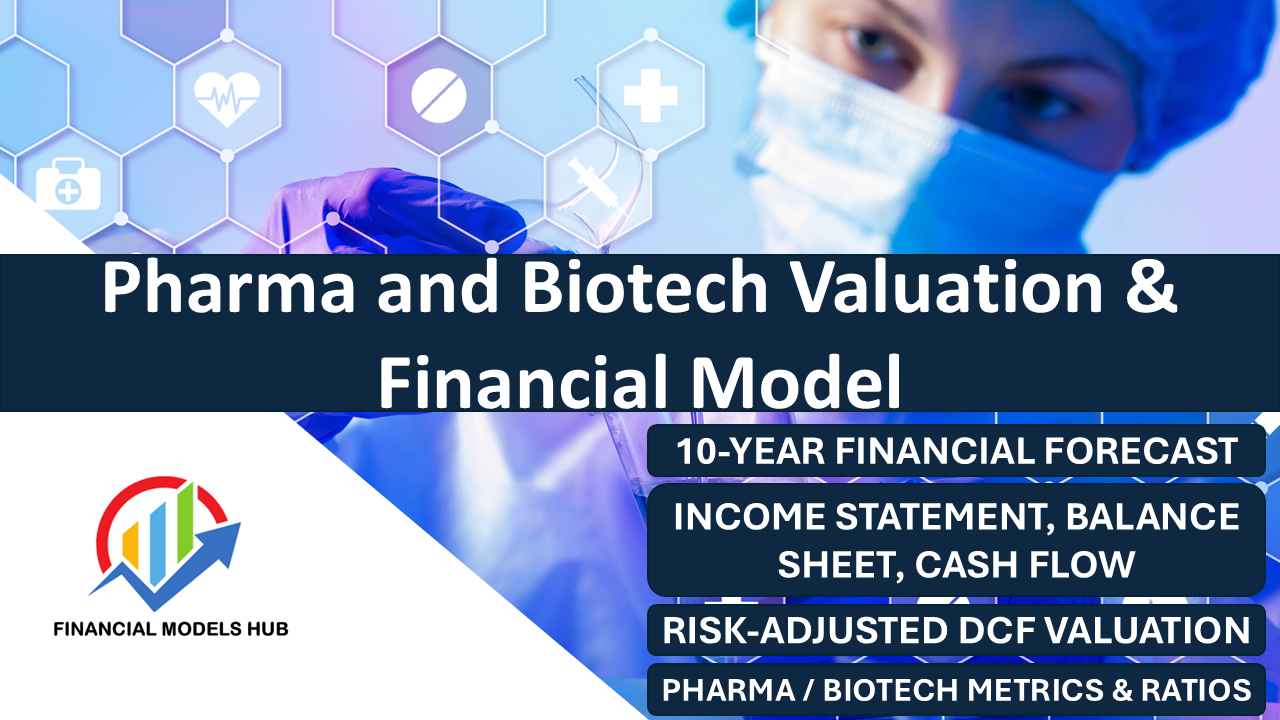The pharmaceutical industry thrives on innovation—but innovation is expensive. To manage risk and capital costs, many drug developers turn to licensing deals. These partnerships between smaller biotech firms and larger pharmaceutical companies help bridge the gap between discovery and commercialization. For investors and analysts, modeling these licensing agreements—especially the royalty and milestone revenue streams—is essential to understanding the true economic potential of a biotech asset.
In this article, we’ll break down how licensing deals work, the components of royalty and milestone payments, and how to model these cash flows in a robust financial forecast. We have also built a ready-to-go Pharma and Biotech Valuation and Financial Model Template for Founders looking for an easy-to-use Financial model which will allow them to model out their company’s financials and provide an Income Statement, Balance Sheet and Cash Flow Statement for their company.

Why Licensing Deals Are Common in Pharma
Developing a drug from discovery to market can cost over $2 billion and take more than a decade. Many smaller biotech companies lack the resources to fund late-stage development, navigate regulatory approvals, or build commercial infrastructure. That’s where partnerships come in. A licensing deal typically allows a larger pharmaceutical company to gain rights (exclusive or regional) to develop, manufacture, and/or sell a product in exchange for:
- Upfront payments
- Milestone payments (clinical, regulatory, or commercial)
- Royalties on future product sales
- Profit-sharing, in some cases
These deals allow biotech companies to monetize innovation earlier, reduce financial risk, and focus on R&D. For pharma, they provide access to promising assets without building them in-house. For a detailed guide, explore How to set pharmaceutical royalty rates.
Core Components of Licensing Revenue
Let’s explore the common types of revenue streams biotech firms receive in licensing deals.
Upfront Payments
These are lump-sum payments made upon signing the deal. They provide immediate capital and typically reflect the perceived value of the asset and the exclusivity of rights.
Milestone Payments
Milestone payments are triggered by specific events, such as:
- Development milestones: e.g., completion of Phase II trials
- Regulatory milestones: e.g., FDA or EMA approval
- Commercial milestones: e.g., first product sale or hitting a sales threshold
Each type of milestone comes with its own payment structure and probability of achievement.
Royalty Payments
These are ongoing payments calculated as a percentage of net sales, often structured as:
- Fixed: A constant percentage (e.g., 8%)
- Tiered: Rates that increase or decrease based on sales thresholds (e.g., 6% for sales < $500M, 10% for sales > $1B), as discussed in Understanding Bucket vs Progressive Royalty Tiers.
- Capped or time-limited: Royalties may expire after a certain time or cumulative payment level
Royalty rates typically range from 5% to 20%, depending on the stage of development, therapeutic area, competition, and deal dynamics.
Profit-Sharing Arrangements
Less common, especially outside of co-commercialization agreements. In this setup, the parties split net profits rather than just sales, often used in regional deals or where the biotech retains commercial rights.
Step-by-Step Guide to Modeling Licensing and Royalty Revenue
Here’s a structured approach to building a model that captures these deal components.
Step 1: Define the Asset Scope
Start by understanding:
- Therapeutic area and market size
- Stage of development (preclinical, Phase I, II, III, or marketed)
- Geographic rights licensed (global or regional)
- Partner responsibilities (clinical development, commercialization, manufacturing)
These factors will drive the expected cash flows and risks. For more details, see Licensing Agreements in the Pharmaceutical Sector.
Step 2: Estimate Sales Forecast
Sales projections are the foundation of royalty modeling. Consider:
- Target population size
- Adoption curve (slow uptake vs. rapid adoption)
- Peak sales and time to peak
- Price per unit and reimbursement
- Market share assumptions
Use analogs or peer benchmarks to validate assumptions. A typical product might ramp to peak sales in 5–8 years post-launch, plateau, and then decline with loss of exclusivity.
Example:
- Year 1 sales: $100M
- Year 5 sales: $800M (peak)
- Price per treatment: $15,000/year
- CAGR (Years 1–5): ~50%
Step 3: Model Royalty Revenue
Apply the agreed royalty rate(s) to your net sales forecast. For tiered royalties, include logic that adjusts the rate based on sales thresholds.
Example:
- Royalty rate: 8% on first $500M, 12% above $500M
- Year 4 net sales = $700M
- $500M × 8% = $40M
- $200M × 12% = $24M
- Total royalty revenue = $64M
Royalty revenue = ∑ (Sales × Royalty Rate) each year during royalty term. Don’t forget to apply geographic or time-based limits if specified (e.g., 10 years from first commercial sale, or until patent expiry).
Step 4: Model Milestone Payments
Milestones are modeled as discrete events with timing and probability assumptions.
Example:
| Milestone Type | Trigger | Payment | Year | Probability | Expected Value |
|---|---|---|---|---|---|
| Phase III Start | Trial initiation | $30M | Year 2 | 80% | $24M |
| NDA Filing | Submission to FDA | $40M | Year 4 | 60% | $24M |
| FDA Approval | Market approval | $60M | Year 5 | 50% | $30M |
| First Commercial Sale | Launch | $20M | Year 6 | 100% | $20M |
| Sales > $500M | Revenue milestone | $50M | Year 8 | 70% | $35M |
Add milestone payments in the years they are most likely to occur, adjusting for probability. For valuation purposes, use risk-adjusted milestone revenues (payment × probability), especially in discounted cash flow (DCF) models. For insights on royalty agreements, explore Royalty Models & Revenue Sharing.
Step 5: Discount the Cash Flows
Apply a risk-adjusted discount rate (commonly 10–15%) to future cash flows to calculate the present value of royalty and milestone revenues. For early-stage deals, higher discount rates (15–20%) may be appropriate due to clinical and regulatory risk. Use the Net Present Value (NPV) of these revenue streams to compare deal attractiveness.
Step 6: Sensitivity and Scenario Analysis
Given the uncertainty in pharma development, test the model against various scenarios:
- High/low sales forecasts
- Alternative royalty tiers
- Faster/slower adoption curves
- Delayed approval or trial failures
This analysis is critical for internal decision-making, investment evaluation, and board-level strategy discussions.
Real-World Example
Consider a biotech company that out-licenses a novel gene therapy in Phase II to a global pharma partner.
Deal terms:
- $50M upfront
- $400M in milestones
- 10% royalty on global net sales
- Sales forecast to peak at $1B by Year 8
- Royalties for 10 years from launch
Revenue forecast (simplified):
| Year | Net Sales | Royalty Revenue | Milestone Revenue |
|---|---|---|---|
| 1–4 | $0 | $0 | $50M (Phase III + NDA) |
| 5 | $50M | $5M | $30M (Approval) |
| 6 | $200M | $20M | $20M (Launch) |
| 7 | $500M | $50M | $0 |
| 8 | $800M | $80M | $50M (Sales milestone) |
| 9–14 | Declining sales | Royalties taper | $0 |
Total undiscounted revenue:
- $50M upfront
- ~$375M royalties
- ~$150M milestones
= ~$575M in deal value
Learn more about best practices in structuring biotech partnerships in Licensing and Collaborations in Life Sciences.
Key Modeling Tips
- Track timing carefully: Misplacing milestone years skews valuation significantly.
- Watch for exclusivity periods: Royalties often end with patent expiration.
- Localize assumptions: Market potential and pricing vary across regions.
- Stay conservative: Use probabilistic modeling for early-stage milestones.
Frequently Asked Questions
What are the typical components of a pharma licensing deal?
A typical licensing deal includes upfront payments, milestone and royalty payments, and sometimes profit-sharing arrangements.
How are royalty rates structured in pharma deals?
Royalty rates can be fixed, tiered, or capped/time-limited, depending on various factors like development stage and market potential. For more details, check Understanding Pharmaceutical Licensing Agreements.
Why is scenario analysis important in revenue modeling?
Scenario analysis helps account for uncertainties in drug development and market dynamics, allowing stakeholders to make informed strategic decisions. Advanced strategies for maximizing licensing deals can be explored in How to maximize the value of licensing deals.
Final Thoughts!
Licensing and royalty revenues are critical to biotech companies’ financial lifelines and often the centerpiece of their valuation. Proper modeling of these complex deal structures enables founders, investors, and analysts to make smarter strategic decisions. By breaking down each revenue stream, layering in probabilities, and accounting for timing, your financial models will more accurately reflect the realities of drug development—and the significant value these partnerships can create.



